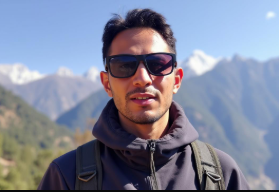Annapurna Panorama Trek
Trip Type
Trekking In Nepal
Accomodation
Tea House
Destination
Nepal
Start Point
Kathmandu
Region
Annapurna Region
Duration
8 Days
Annapurna Panorama trek is a short and iconic trek in the western region of Nepal. This trek is ideal for those who have limited time or those who are seeking less adventurous trek. The altitude in this trek is not so high; it is ideal for a family trip. This trek offers diverse landscapes, mountain views, rich culture and tradition of the local ethnic community.
Seasonal Information:
The weather varies according to the season in the Annapurna region that influence the experience of trekkers.During spring season (March-May), the temperature is moderate, you get to see clear skies, with vibrant rhododendron blooms.Likewise in Autumn season(September-November), which is the most popular for trekking that offers stable weather and excellent visibility. Also the temperatures at day time are comfortable compared to night one.For Winter Season(December-February), the region suffers cold temperature, primarily at higher altitudes and snow may cover some of the trails which makes it more challenging for trekkers.lastly for Monsoon(June-August), rainfall can make trails slippery and risky.Despite that the rich greenery gives the unique perspective to the region.
Cultural and Natural Insights:
From cultural aspects, the route passes through villages like Ghandruk and Ulleri where Gurung and Magar communities live. They are known for their warm hospitality and their rich culture. In autumn, you can feel the festive vibes like Dashain and Tihar which are the main festivals of Nepalese people. You can enjoy and experience Magar and Gurung dances in villages. You can enjoy local food like Tibetan bread, special Thakali cuisine. From natural aspects, You can see the diverse landscape from Rhododendron forest to Oak forest. You can see 360 views of mountain ranges like Annapurna, Dhaulagiri, Machapuchhre, and Hiuchuli. Poon Hill offers the best photography view of sunrise and sunset. You can encounter Monal bird which is the national bird of Nepal.
Preparation Guide:
-
For Physical fitness: This trek is suitable for beginners also with many ascents and descents . So you need to be physically fit to walk for long hours.
-
For packing list:
-
For clothes, you need layered clothing like thermal, jackets, base layer, fleece.
-
For footwear, waterproof trekking boots with good grip is needed.
-
For gear, you need trekking poles, headlamp, and a day pack.
-
Sunscreen, power banks, sunglasses, water purification tablets are required.
-
You need a TIMS card and Annapurna Conservation Area Permit(ACAP).
-
For altitude prevention you need to stay hydrated and avoid alcohol. You need to consider carrying medication like Diamox incase of an emergency.
Sustainability and Responsibility:
The ecosystem of Annapurna region has been significantly impacted by increasing tourism. Trekkers have some responsibilities towards the environment to preserve the beauty of the Himalayas for our own good and for the future generation. Here are some ways to practice environmental responsibility:
-
You can carry garbage bags with you or dispose of trash in designated areas.
-
Avoid using single use plastic water bottles.
-
Choose accommodation that follows sustainable practice.
-
You can purchase local goods to uplift/ support the local economy.
-
Avoid picking rare plants that take long to grow and respect wildlife and their habitat.
-
Travel in groups to reduce ecological strain.
Modern Trekkers Expectations:
Now trekkers seek balance between adventure and the outside world while in trek to be connected. Here are some expectation of modern traveller that we try to meet:
-
Internet access as wifi is available at Kagbeni, Jomson, and Muktinath.
-
Comfortable accommodation due to upgraded hygiene facilities.
-
Available expanded menu of options including pizza, pancakes, and vegetarian dishes.
-
You can enjoy thakali sets, momos, and apple pies for food.
-
Sustainable and ethical practices as sustainable practice of waste management and using renewable energy.
-
The trek is through remote valleys and high altitude passes.
-
You can combine the trek with the highest lake in Nepal that is Tilicho.
If you like Annapurna Panorama Trek, you might also like these treks:
Highlights of the Annapurna Panorama Trek
-
This trek is ideal for families, beginners due to its short duration.
-
Panoramic view of Mountains
-
You can witness the sunrise over Annapurna and Dhaulagiri range from Poon Hill
-
This trek has low risk of altitude sickness
-
You can experience the diverse landscapes.
-
You can explore the culture and tradition of Gurung and Magar in villages like Ghandruk and Ulleri.
Short Itinerary ( 8 days )
Arrival in Kathmandu and you’ll take a flight to Pokhara or go by road. Once you reach Pokhara, you can explore Phewa Lake, Pagoda. Stay overnight at a hotel in Pokhara.
Now the actual trek journey starts from here. Walking hours: 4–5 hrs, Distance: 10 km, Altitude gain: 570 m.
Which will be our next checkpoint and stay at a guesthouse. Walking hours: 5–6 hrs, Distance: 13 km, Altitude gain: 1,280 m.
To watch the stunning sunrise and return back from the destination, and again trek to Tadapani (2,610 m).
Start the day with a trek to Ghandruk, descending through rhododendron forest, with a view of Annapurna South and Machhapuchhre mountains. Distance: 7 km, walking hours: 3–4 hrs, altitude loss: 690 m.
The last day to trek by descending through forest, village, and crossing Modi Khola. After reaching Nayapul, we’ll drive to Pokhara and stay overnight and conclude your trek. Distance: 13 km, walking hours: 5–6 hrs, altitude loss: 870 m.
When you reach Pokhara, you can explore the city, Phewa Lake. You can go ziplining, bungee jumping, and paragliding in Sarangkot.
You’ll take a flight to Kathmandu or go by road to Kathmandu and transfer to the international airport, concluding the trek.
Cost Includes
-
Cost of permits and paperwork
-
Transportation cost
-
Accommodation
-
Meals and Drinks
-
Cost of trekking staff
-
Miscellaneous cost like government tax and service
Cost Excludes
-
Personal expenses
-
Trekking gear and equipment
-
Insurance and emergency cost
-
Tips for guide or porter


.png)

